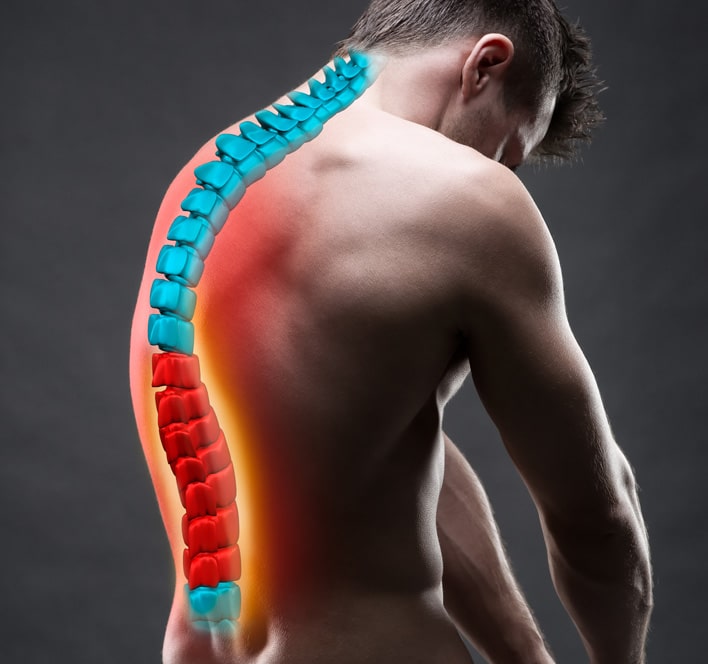Spinal deformities often create an abnormal curvature of the spine. For example, kyphosis is the curvature of the thoracic spine, causing a hunched or rounded back. But how is kyphosis different from lordosis? The differences in spine curvature types depend on where in the spine these curvatures occur.
No matter the type of spinal issue or how severe it is, our team at NJ Spine & Orthopedic can advise you on how to relieve your symptoms and regain your quality of life after evaluating your medical records. We will work with you every step of the way to mitigate pain and treat your spinal symptoms. Our Concierge Team can also help make sure everything moves smoothly for your appointments to help reduce stress.
What Is the Difference Between Lordosis and Kyphosis?
The spine has three segments that curve in different ways for flexibility of movement and to distribute weight evenly. The top and bottom sections of the spine, the cervical and lumbar spines, curve inward, forming a backward C-shape. The thoracic spine, which connects the cervical and lumbar spines, curves outward, creating a standard C-shape.
While kyphosis affects the thoracic spine, lordosis typically affects the lumbar spine. Still, it can sometimes affect the cervical spine as well. Also, while a deformed kyphosis thoracic spine curves from front to back, resulting in a hunched or rounded back, a distorted lordosis lumbar spine curves from back to front, displaying an exaggerated arch or inner curve in the lower back.
The typical measurement of a kyphosis curve is 20 to 45 degrees, and a lumbar lordosis curve should typically be 40 to 60 degrees. The thoracic spine is considered deformed when the curve measures above 45 degrees, and any measurement less than 40 degrees determines an abnormality in the lumbar spine.
Lordosis and Kyphosis Symptoms
These symptoms often occur during childhood or adulthood. The range of symptoms commonly overlap, as when the spine moves, it’s in a position where it’s not supposed to be. These deformities can interfere with the functions of organs and nerves, presenting symptoms such as:
- A visible abnormal deformation of the back
- Dull and achy pain
- Sharp and shooting pain
- Pain after extended periods of standing or sitting
- Stiffness
- Numbness or tingling
- Breathing difficulties
As the issue grows more pronounced, the symptoms may grow more intense. If you are noticing visible changes in your posture, it’s best to meet with a professional who can provide you with treatment options that will slow down the progression and relieve your symptoms.
Do Treatment Options Differ Between Kyphosis and Lordosis?
Both of these conditions may be caused by osteoporosis. In this case, the course of treatment may include staying regularly active with weight-bearing aerobic exercises like walking, stair climbing, and gardening. This can help slow bone loss and strengthen already weakened bones. Incorporating more calcium and vitamin D into your diet and hormone replacement therapy into your lifestyle could also help osteoporosis progression.
Obesity is another cause of lordosis, so prevention or diminished progression can be instituted with lifestyle changes in diet and activity level. Kyphosis can be prevented or slowed down by doing exercises and physical therapy activities that help eliminate poor posture habits. If both conditions continue to progress and the symptoms grow more intense, pain medication, braces, and surgery may be needed.
The Spine Curvature Orthopedic Doctors at NJ Spine & Orthopedic Can Relieve Spine Curvature Symptoms
At NJ Spine & Orthopedic, spine curvature medical professionals have extensive expertise and experience with spine curvature issues. We know what treatments will help you to relieve symptoms related to your spine curvature. If all conventional therapies fail, we can perform surgery to eliminate or significantly reduce symptoms.
Our orthopedic doctors at NJ Spine & Orthopedic are the leading authority on spinal conditions, even the most severe ones. These doctors can use their vast experience in spine curvatures to restore your spinal health. Call (866) 553-0612 or complete our contact form if you need relief from symptoms caused by the abnormal curvature of your spine.

